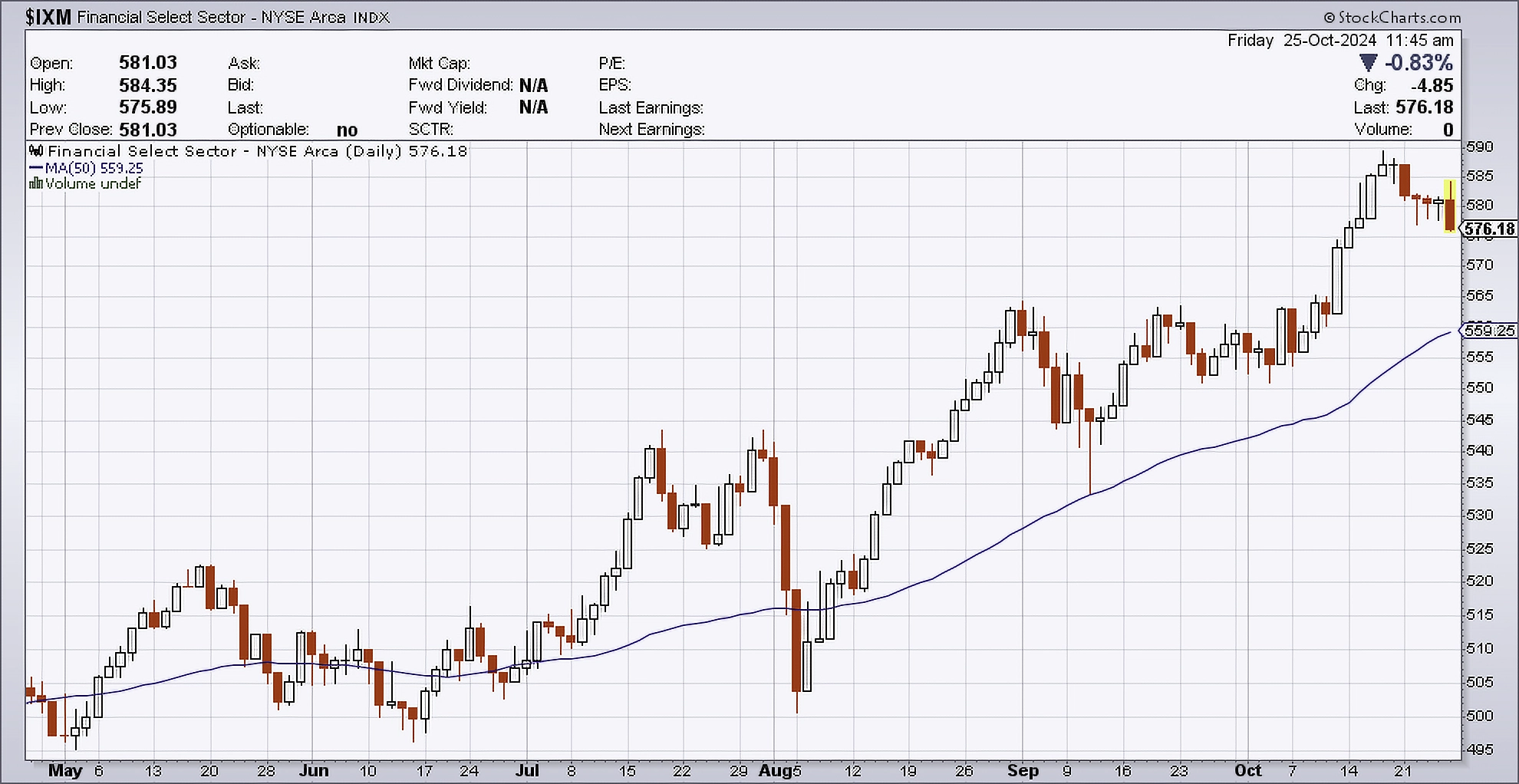Editor’s note: Any and all references to time frames longer than one trading day are for purposes of market context only, and not recommendations of any holding time frame. Daily rebalancing ETFs are not meant to be held unmonitored for long periods. If you don't have the resources, time or inclination to constantly monitor and manage your positions, leveraged and inverse ETFs are not for you.
As the U.S. presidential election draws closer, traders are eyeing sectors that could potentially see big moves, and financial stocks are at the top of that list. Given the high sensitivity of the financial sector to tax policies, regulatory changes, and the Federal Reserve’s direction, financial stocks may offer a timely trading opportunity.
Although artificial intelligence (AI) and large-cap tech get all the attention, the financial sector has been a quiet outperformer so far this year. The Financial Select Sector Index* was up 25.2% year to date as of October 31, 2024 compared with 21.0% for the S&P 500 Index, according to S&P Dow Jones Indices. The index is also comfortably above its 50-day moving average*.
Below is a daily chart of the Financial Select Sector Index as of October 25, 2024.

Source: StockCharts.com, October 25, 2024.
Candlestick charts display the high and low (the stick) and the open and close price (the body) of a security for a specific period. If the body is filled, it means the close was lower than the open. If the body is empty, it means the close was higher than the open.
The performance data quoted represents past performance. Past performance does not guarantee future results.
How the Election Outcome Could Impact Financial Stocks
The polls and betting markets are pointing to a tight race in the U.S. presidential election on November 5. The two candidates, Donald Trump and Kamala Harris, have differing stances on issues that could impact banks and the rest of the financial sector. Here’s how a Harris or Trump victory might impact the financial sector based on tax policies, regulations like Dodd-Frank and Fed policy.
Tax Policies and Corporate Tax Rates
- Trump: Historically, Trump has favored lower corporate tax rates, aiming to keep taxes low for banks and other corporations. A Trump victory could mean efforts to maintain or even reduce corporate tax rates further, which may boost financial sector profitability.
- Harris: A Harris win may signal potential corporate tax increases, particularly for high-earning companies, as part of a broader effort to support social programs or other spending initiatives. This could pressure bank earnings.
Financial Regulation
- Harris: A Harris administration would likely advocate for reinstating stricter regulations to protect consumers and reduce systemic risks in the financial system. Enhanced oversight might focus on risk management and transparency, which could increase compliance costs for banks but potentially provide a more stable long-term environment.
- Trump: Trump’s administration rolled back parts of Dodd-Frank and prioritized deregulation, aiming to reduce compliance costs for banks and financial institutions. A return to this policy could mean less regulatory oversight and potentially higher risk-taking by banks, which often boosts short-term profitability.
Fed Policy and Interest Rates
- Harris: In September, the Fed announced a 50-basis-point* rate cut, its first cut in four years. Harris may support Fed independence but could indirectly influence a more balanced approach to interest rate management if her administration prioritizes economic stability and inflation control. A balanced rate approach may lead to cautious growth in credit markets.
- Trump: Trump has previously pressured the Fed for low interest rates to stimulate economic growth. A re-election could mean ongoing advocacy for low rates, benefiting certain types of lenders but potentially reducing profit margins for banks reliant on higher rates.
Trading the Financial Sector in Both Directions with Leverage
For traders seeking to capitalize on financial sector movements influenced by perceived election-related conditions, Direxion’s Daily Financial Bull 3X Shares (Ticker: FAS) and Daily Financial Bear 3X Shares (Ticker: FAZ) offer strategic options. FAS and FAZ seek daily investment results, before fees and expenses, of 300%, or 300% of the inverse (or opposite), respectively, of the performance of the Financial Select Sector Index.
However, traders must understand the risks associated with leverage. While these ETFs offer potential for significant gains, they also pose substantial losses, making them suitable for those capable of managing leverage risks and targeting short-term trends in the financial sector.
*Definitions and Index Descriptions
An investor should carefully consider a Fund’s investment objective, risks, charges, and expenses before investing. A Fund’s prospectus and summary prospectus contain this and other information about the Direxion Shares. To obtain a Fund’s prospectus and summary prospectus call 866-476-7523 or visit our website at www.direxion.com. A Fund’s prospectus and summary prospectus should be read carefully before investing.
Leveraged and Inverse ETFs pursue daily leveraged investment objectives which means they are riskier than alternatives which do not use leverage. They seek daily goals and should not be expected to track the underlying index over periods longer than one day. They are not suitable for all investors and should be utilized only by sophisticated investors who understand leverage risk and who actively manage their investments.
The Financial Select Sector Index (IXMTR) is provided by S&P Dow Jones Indices and includes securities of companies from the following industries: Banks; Thrifts & Mortgage Finance; Diversified Financial Services; Consumer Finance; Capital Markets; Insurance; and Mortgage Real Estate Investment Trusts (REITs).
The S&P 500® Index is designed to be comprised of stocks that are the 500 leading, large-cap U.S. listed issuers. The securities are selected on the basis of market capitalization, financial viability of the company, sector representation, public float, liquidity and price of a company’s shares outstanding. The Index is a float-adjusted, market capitalization-weighted index.
One cannot directly invest in an index.
The “Financial Select Sector Index” is a product of S&P Dow Jones Indices LLC (“SPDJI”), and has been licensed for use by Rafferty. Standard & Poor’s® and S&P® are registered trademarks of Standard & Poor’s Financial Services LLC (“S&P”); Dow Jones® is a registered trademark of Dow Jones Trademark Holdings LLC (“Dow Jones”); and these trademarks have been licensed for use by SPDJI and sublicensed for certain purposes by Rafferty. Rafferty’s ETFs are not sponsored, endorsed, sold or promoted by SPDJI, Dow Jones, S&P, or their respective affiliates and none of such parties make any representation regarding the advisability of investing in such product(s) nor do they have any liability for any errors, omissions, or interruptions of the Financial Select Sector Index.
Direxion Shares Risks – An investment in a Fund involves risk, including the possible loss of principal. A Fund is non-diversified and includes risks associated with the Fund’s concentrating its investments in a particular industry, sector, or geography which can increase volatility. The use of derivatives such as futures contracts and swaps are subject to market risks that may cause prices to fluctuate over time.
Leverage Risk – Each Fund obtains investment exposure in excess of its net assets by utilizing leverage and may lose more money in market conditions that are adverse to its investment objective than a fund that does not utilize leverage. A total loss may occur in a single day. Leverage will also have the effect of magnifying any differences in the Fund’s correlation or inverse correlation with the Index and may increase the volatility of the Fund.
Daily Index Correlation Risk – A number of factors may affect the Bull Fund’s ability to achieve a high degree of correlation with the Index and therefore achieve its daily leveraged investment objective. The Bull Fund’s exposure to the Index is impacted by the Index’s movement. Because of this, it is unlikely that the Bull Fund will be perfectly exposed to the Index at the end of each day. The possibility of the Bull Fund being materially over- or under-exposed to the Index increases on days when the Index is volatile near the close of the trading day.
Daily Inverse Index Correlation Risk – A number of factors may affect the Bear Fund’s ability to achieve a high degree of inverse correlation with the Index and therefore achieve its daily inverse leveraged investment objective. The Bear Fund’s exposure to the Index is impacted by the Index’s movement. Because of this, it is unlikely that the Bear Fund will be perfectly exposed to the Index at the end of each day. The possibility of the Bear Fund being materially over- or under-exposed to the Index increases on days when the Index is volatile near the close of the trading day.
Financials Sector Risk — Performance of companies in the financials sector may be materially impacted by many factors, including but not limited to, government regulations, economic conditions, credit rating downgrades, changes in interest rates and decreased liquidity in credit markets.
Additional risks of each Fund include Effects of Compounding and Market Volatility Risk, Market Risk, Counterparty Risk, Rebalancing Risk, Intra-Day Investment Risk, Other Investment Companies (including ETFs Risk), Cash Transaction Risk, Passive Investment and Index Performance Risk and for the Direxion Daily Financial Bear 3X Shares, Shorting or Inverse Risk. Please see the summary and full prospectuses for a more complete description of these and other risks of a Fund.
